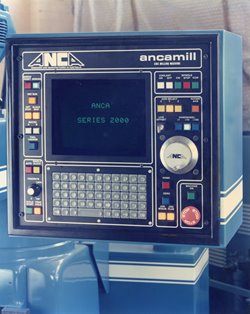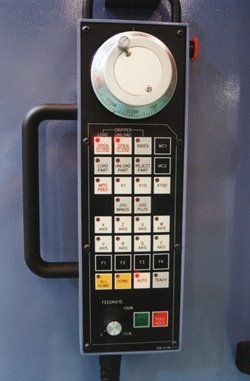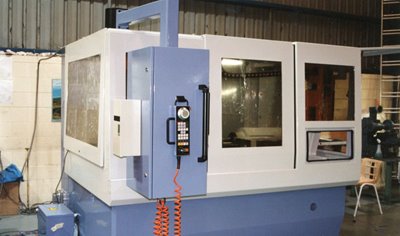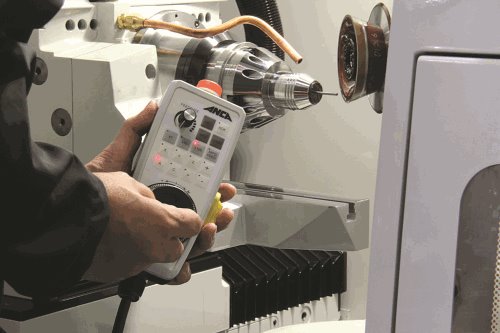News and Resources
Blog
ANCA Motion has over 40 years of proven experience and innovation. ANCA was one of the first to design and manufacture a handheld remote pendant for our CNC machines, the first being in 1994 for the ISG6 machine (Integrated Slot Grinder 6-axis Machine), with the current version of the pendant released in 2015 with the FX machine range.
Ian Rees has been with the ANCA Group for over 30 years. Starting with ANCA CNC Machines in 1988, Ian’s role was to design and develop the CNC control systems (System 32 and System 16) for the first generation of machines. Eventually, ANCA started utilising these CNC control systems for other types of machines, selling them to OEMs in laser cutting and food packaging; this led to the formation of ANCA Motion in 2008.
Ian worked closely with ANCA Co-Founder Pat McCluskey to design and build one of the first handheld Remote Pendants for a CNC machine locally in Bayswater, Melbourne, Australia in 1994.
Ian is now the Hardware Engineering Team Leader at ANCA Motion.
What was the motivation to develop a handheld remote pendant?
Ian Rees: Machine operator control panels require a set of specific functions to enable the machine to be configured and used for manufacturing cycles.
Historically, these functions such as feed rate control, axis selection switches for MPG control and Emergency stop functions were on large operator front panels.
The disadvantage of having an MPG on the front panel is that the operator may need to be away from the front panel during machine configuration.
The Pendant offered a solution to this issue by moving the functions from the front panel Human Machine Interface (HMI) onto a more convenient handheld device.

;.aspx?width=210&height=315) (some early ANCA machine front panel HMIs)
Ian:
(some early ANCA machine front panel HMIs)
Ian: The first handheld remote pendant that we designed was in 1994 for a machine called the ISG6 (Integrated Slot Grinder 6-axis Machine) using the System 32 CNC control.
I did the design of the electronics inside this Pendant. Pat McCluskey did the mechanical design.
More than 20 years later, and we’re both still involved in the Remote Pendant. WOW.

 (ANCA's first go at the handheld Remote Pendant in the ISG6 machine in 1994)
Ian: Today’s Remote Pendant
(ANCA's first go at the handheld Remote Pendant in the ISG6 machine in 1994)
Ian: Today’s Remote Pendant uses the EtherCAT fieldbus for communication operating at 100MB/s.
The ISG6 Pendant used a fieldbus called “BitBus” based on an old, obsolete Intel 8-bit microcontroller. Its communication speed was 4MB/s, quite fast in 1994.
These ISG6 Pendants were so bullet-proof and reliable, we never had them fail in the field.
It was a strong, metal enclosure that was much, much larger and heavier than today’s Remote Pendant. That’s 25 years of technology right there.
What are the typical challenges you faced in the development of this product and how did you overcome them?
Ian: The product development timeframe was critical to meet the delivery of the first FX series of machines, which were released in 2015.
Without the Remote Pendant, it was not possible to use the machine. Pat McCluskey conceptualised the Remote Pendant as the architect of the FX series.
Working closely with Pat and his requirements, we were able to deliver the Remote Pendant prototypes in die-cast hand-held enclosures on-time for the first FX machine.
 (The Remote Pendant with the FX Machine)
Ian:
(The Remote Pendant with the FX Machine)
Ian: While these die cast Pendants satisfied the initial 100 or so machines, a plastic injection moulded case and cover was designed for the mass production product which we have today.
This plastic case design integrated 18 small polycarbonate light pipes for the LEDs located next to the switches on the Pendant’s front panel.
The printed circuit board took several weeks to design and develop which includes EtherCAT connectivity and an interface PCB for the machine connectivity.
It was satisfying to meet the delivery ahead of the required schedule after committing eight weekends in the office to deliver on time to ANCA CNC Machines.
How did it evolve into other industries down the line?
Ian: ANCA Motion now makes the Pendant for various grinding applications, but also for many other CNC application areas such as profile cutting. We have, however, sold many into varied industrial automation applications that also require precise operator control.
The EtherCAT Remote Pendant is a niche product for this market and the applications it can be used for are expanding.
Today, ANCA Motion offers
the AMI5000 Remote Pendant as a portable, light-weight machine control interface, with seamless integration with EtherCAT control systems. The buttons can be configured for specialized applications, and has the flexibility to add custom logos, designs and colours to meet branding requirements.
15 May 2020